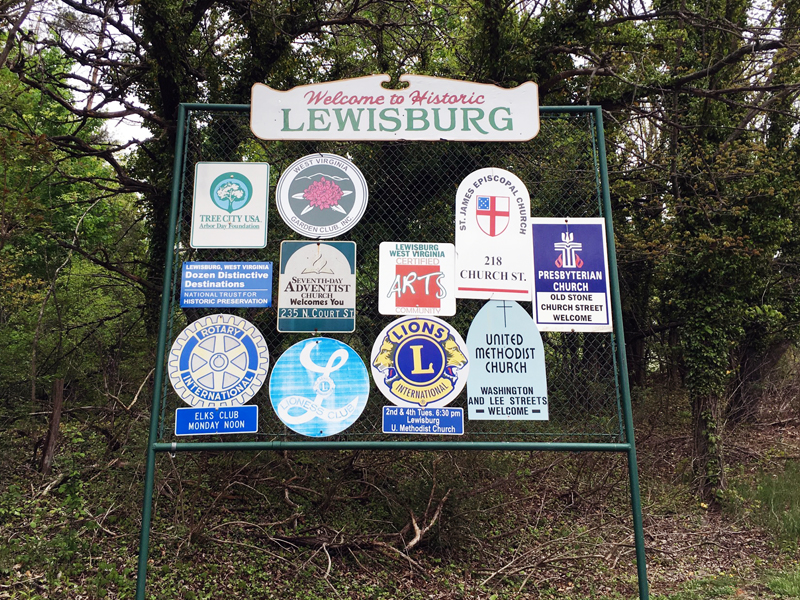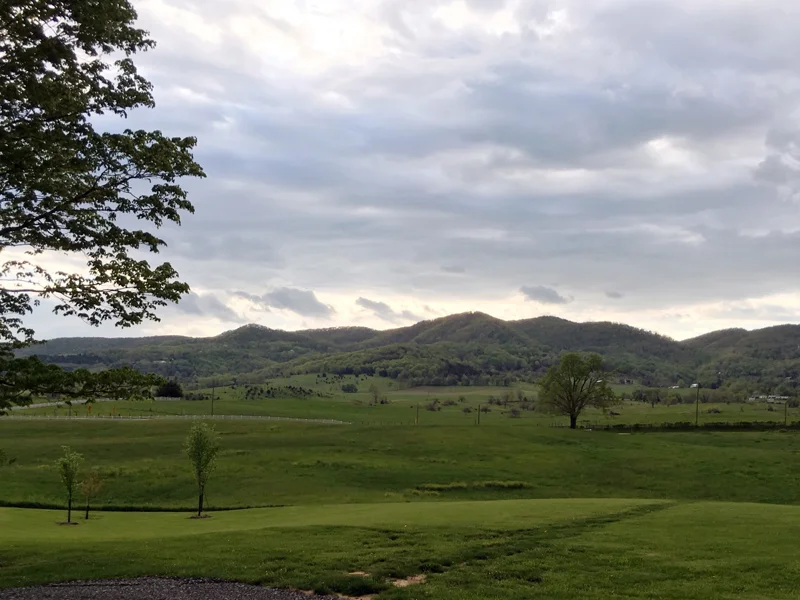Shaw: Union, West Virginia
May 5-8, 2016
Capturing our trip together has been extremely difficult. I am having a hard time putting anything down because I still feel confused about what I am looking for, and I know that everything I say is filled with that confusion.
—Shaw
“There is a crack in everything. That’s how the light gets in.”
—Leonard Cohen
Nancy and I drove from New York to Union, West Virginia instead of flying because I thought we could experience the changing landscape and it would give us more of a sense of place, specifically the South. For seven hours we talked a lot about our own lives: I have one parent from the South and one from the North and have recently understood that I have ancestors who were enslavers; she is from parents who immigrated their family to the US from Korea. I grew up in New York, Nancy in DC. I wondered how we are informed by our heredity and ancestors when we don’t have direct experience with their historical, geographical and cultural contexts. I was hoping this trip would help me face a heredity that includes enslavement and also help me better understand the relationships of European and African Americans. I wouldn’t have gone without Nancy’s “contest” to name the place that is calling you. It felt like amazing serendipity to be able to take this journey with someone who could be objective and who, as an artist, was looking for people to engage.
As we drove south, I talked of my interest in the overlapping histories of black and white people. I think my racial identity was confused as a child. Though I lived as a white person within what is mostly a segregated white culture—even in diverse New York City—there was an emotional part of me that identified with what I saw as a black sensibility, and I have struggled with—and not been able to reconcile—the polarization of race. Nancy described her experience of the tension between black and white cultural identities in public school and her own position as an Asian American moving within that. I had been reading a lot about the history of slavery so we talked about it and Jim Crow and the current state of violence and segregation. It matters to me if there are distant relatives who are black because not admitting we have a shared cultural and genetic past has been central to the denial required to sustain institutional racism. What kind of character and ethics have been passed down in my family, a family that was able to compartmentalize race when dealing with friends, neighbors, employees and possibly their own family members or children?
The drive was highway all the way down and into the midst of the Allegheny Mountains, which were rounded, green and misty. Driving did not really bring us any closer to knowing a landscape than looking down from a plane. Nothing on this trip was going to give itself away easily or become clear; our heredity is still in flux, there are no simple answers that are true for all. I am a little lost.
Union was where my great, great grandmother with the diary was from and where her grandfather’s will listed slaves. Nancy booked an Airbnb with Lynn in Lewisburg, the next town over from Union. Lynn had come to West Virgina from the north decades ago when there was a migration of people looking for a rural life, communes and traditional knowledge. When Nancy and I introduced our trip to Lynn, she gave us the names of people to call: the director of the historical society in Union; the owners of Elmwood, a Greek revival house built by my ancestor with the will; and a woman who had curated an exhibition to commemorate African Americans.
We began to see a relationship between north and south, a flow back and forth by both whites and blacks. Here again, there would not be an easily identifiable, static and two-dimensional way to recognize regional culture. And yet I know there are nuanced intricacies inherent to the history and people of this place that we could not see.
Nancy and I worked as a team. When one was hesitant, the other stepped forward, and we bounced off each other to ask more questions and to help diffuse situations. Nancy distracted Larry, the part-time archivist at North House—Lewisburg’s historical society—with questions about the town’s asylum, while I tried to probe into questions of race. Larry showed us the ledger of Anthony Carter, a slave freed by Henry Erskin. Carter, formerly a grave digger, became a successful cobbler. Larry showed us stacks of registration papers from after Emancipation when blacks had to register with the court house and carry papers. They were required to have a job and a place to live. Otherwise, they had to leave the county to avoid being jailed. I asked Larry why he thought someone would be freed. I suggested it could be because of blood, but Larry said he wasn’t so sure. He told us of Carol Haynes, a lawyer in New Orleans who had been tracing the “tiniest records of blacks” because so little was recorded. Larry claimed that the locals didn’t have a problem with race and he attributed hard work to where he was in his own life. When I asked him if he would have had the same opportunities were he black, he conceded that he would not.
We were invited to Elmwood in the evening. Driving to Union was quite pastoral with green, spacious and rolling land. From the road, Elmwood appeared on a hill to the left. Red with white columns, it was dramatic and ostentatious. A house inspired by Jefferson’s Monticello, it was built in 1835 to impress the young wife of Hugh Caperton. It smelled of paint and wine when we entered. The owners, Chris and Anita, had been renovating the neglected building for three years. When Chris referred to Elmwood as my “ancestral home” it left me cold. I cannot place myself in relation to the geography, architecture or surnames. The gap between my grandmother’s grandmother and me is too big. I don’t have any real sense of belonging to this history, yet something nags at me about it. Like cobwebs, there must be something that sticks to us from the past that we can’t see. Chris and Anita told us a Civil War reenactment was scheduled for August and they really wanted to see my ancestor’s diary for authentic stories from that time. We asked if a Civil War reenactment wasn’t problematic. Chris described himself as a self-made man. I asked pointedly if his success was more possible because of the currency of his skin color and he admitted that it probably was. Nancy turned our discussion to current politics.
The cemeteries were traditionally segregated. Nancy found Alice Beulah Caperton’s stone at Greenhill, the white cemetery; I put buttercups in it for the grandmother of my grandmother. We also went to the black cemetery. On an opposite hill behind Elmwood, it was much smaller, with wire fencing and a pasture gate, surrounded by calves, cows, and buttercups. We found the tombstone of Oliver Twist Dickens. On our way down we jumped an electric fence.
It should not have been a surprise that finding African Americans to talk to was harder than finding European Americans. We did not see many African Americans on the streets in either town. The black population there is now quite low, especially in Union. I think the population was 50/50 at the beginning of the twentieth century. Lewisburg seemed like a tourist town without many locals visible. There are no black churches in Union; when there were only a couple of congregants left, they donated the last black church to the historical society. There are still two black churches in Lewisburg, one Baptist and one Methodist.
I called Janice who had mounted an exhibition of photographs of African Americans, “Invisible Roots and Legends” at Carnegie Hall, Lewisburg’s cultural center where our host Lynn is the Artistic Director. The project was a result of returning to the area after 40 years and discovering “there was nothing about African American history… it was almost like they were invisible.” “We’re all connected somehow,” she continued. “These photographs are a way of opening up history so we can talk about things.” She said she was surprised that the show was so well attended by both whites and blacks, and by how moved they were. She asked me what I was after; I told her I wanted to open up my past, acknowledge it and ask questions of my position now, but that I was pretty lost in it. She told me I was brave and to keep working.
We had an appointment with Fred, Director of the Monroe County Historical Society in Union and Professor Emeritus from the University of Chicago. For us, he opened the historical society—formerly Hugh Caperton’s office—although it was off-season. I had no idea the family name and the diary would act as such access tickets. Ron, a retired dentist from Baltimore, who was raised in Union joined us. He and Fred said, “We heard you had a late night with Chris and Anita.” When I asked about race relations, Ron said racial problems were in the past. I asked about shared genetic histories between whites and blacks from slavery and there was general acknowledgment only, nothing local. But, he recalled a couple of black people at a white funeral who said they were there because they were related. Fred, a geologist, told us about the tectonic plates that collided millions of years ago to form the Allegheny Mountains. I bought stapled publications titled “Elmwood Letters” and “Slaves of Monroe County” which included introductions written by Fred. In them are lists of names. Sometimes noted are descriptors as mulatto or black, monetary values and names of purchasers.
Mother’s Day. We decided to see if we could attend Sunday school at Tabor Baptist Church. As we pulled up, so did Paula, a member of the congregation who moved from Brooklyn. When I asked if we could visit the service even though we were not dressed for church, she told us we were welcome in God’s house and lent us her workbook. Nancy had not thought of New York as being segregated, but meeting members of the Tabor Church who settled in Lewisburg to escape the violence in the Bronx and Queens pointed to the segregation in New York. This was another example of changing social landscapes… and the relationship of north and south… and histories of migration and the effects of segregation in different parts of the country, in different ways.
Then Nancy and I drove north talking the whole way just as we had going down.













